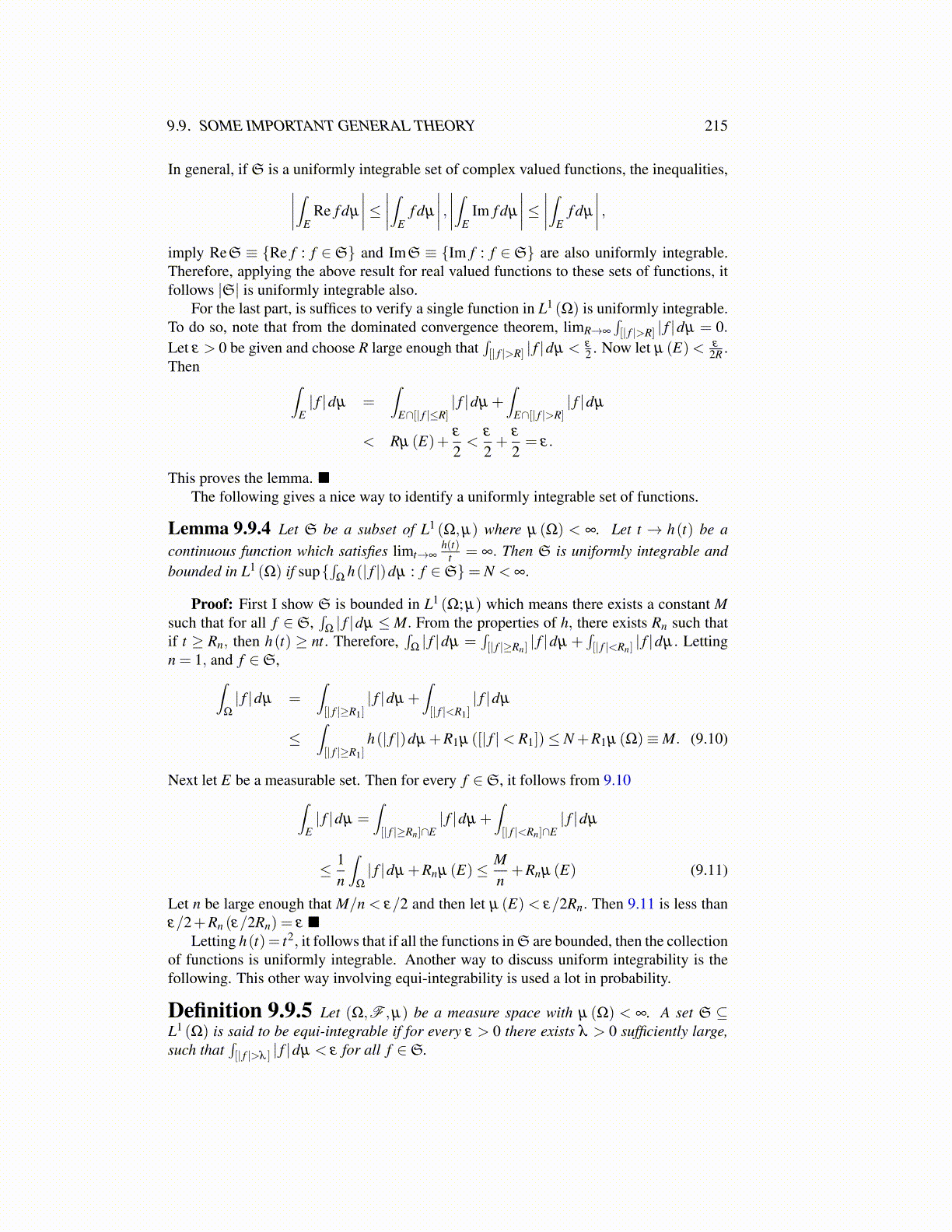
9.9. SOME IMPORTANT GENERAL THEORY 215
In general, if S is a uniformly integrable set of complex valued functions, the inequalities,∣∣∣∣∫ERe f dµ
∣∣∣∣≤ ∣∣∣∣∫Ef dµ
∣∣∣∣ , ∣∣∣∣∫EIm f dµ
∣∣∣∣≤ ∣∣∣∣∫Ef dµ
∣∣∣∣ ,imply ReS ≡ {Re f : f ∈S} and ImS ≡ {Im f : f ∈S} are also uniformly integrable.Therefore, applying the above result for real valued functions to these sets of functions, itfollows |S| is uniformly integrable also.
For the last part, is suffices to verify a single function in L1 (Ω) is uniformly integrable.To do so, note that from the dominated convergence theorem, limR→∞
∫[| f |>R] | f |dµ = 0.
Let ε > 0 be given and choose R large enough that∫[| f |>R] | f |dµ < ε
2 . Now let µ (E)< ε
2R .Then ∫
E| f |dµ =
∫E∩[| f |≤R]
| f |dµ +∫
E∩[| f |>R]| f |dµ
< Rµ (E)+ε
2<
ε
2+
ε
2= ε.
This proves the lemma. ■The following gives a nice way to identify a uniformly integrable set of functions.
Lemma 9.9.4 Let S be a subset of L1 (Ω,µ) where µ (Ω) < ∞. Let t → h(t) be acontinuous function which satisfies limt→∞
h(t)t = ∞. Then S is uniformly integrable and
bounded in L1 (Ω) if sup{∫
Ωh(| f |)dµ : f ∈S}= N < ∞.
Proof: First I show S is bounded in L1 (Ω; µ) which means there exists a constant Msuch that for all f ∈S,
∫Ω| f |dµ ≤M. From the properties of h, there exists Rn such that
if t ≥ Rn, then h(t) ≥ nt. Therefore,∫
Ω| f |dµ =
∫[| f |≥Rn]
| f |dµ +∫[| f |<Rn]
| f |dµ. Lettingn = 1, and f ∈S,∫
Ω
| f |dµ =∫[| f |≥R1]
| f |dµ +∫[| f |<R1]
| f |dµ
≤∫[| f |≥R1]
h(| f |)dµ +R1µ ([| f |< R1])≤ N +R1µ (Ω)≡M. (9.10)
Next let E be a measurable set. Then for every f ∈S, it follows from 9.10∫E| f |dµ =
∫[| f |≥Rn]∩E
| f |dµ +∫[| f |<Rn]∩E
| f |dµ
≤ 1n
∫Ω
| f |dµ +Rnµ (E)≤ Mn+Rnµ (E) (9.11)
Let n be large enough that M/n < ε/2 and then let µ (E) < ε/2Rn. Then 9.11 is less thanε/2+Rn (ε/2Rn) = ε ■
Letting h(t)= t2, it follows that if all the functions in S are bounded, then the collectionof functions is uniformly integrable. Another way to discuss uniform integrability is thefollowing. This other way involving equi-integrability is used a lot in probability.
Definition 9.9.5 Let (Ω,F ,µ) be a measure space with µ (Ω) < ∞. A set S ⊆L1 (Ω) is said to be equi-integrable if for every ε > 0 there exists λ > 0 sufficiently large,such that
∫[| f |>λ ] | f |dµ < ε for all f ∈S.